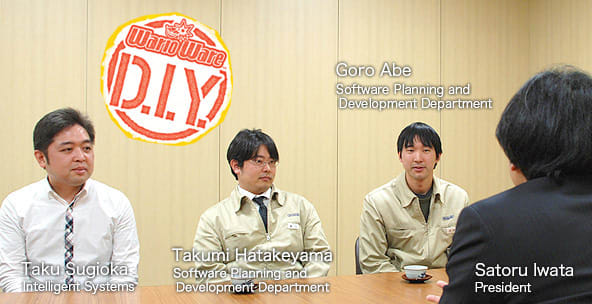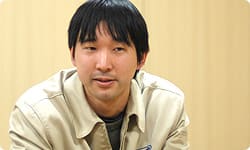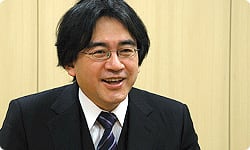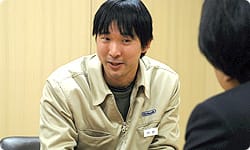It All Started More Than Five Years Ago
What kicked off development of WarioWare: D.I.Y. ? Abe-san, would you start us off?
Sure. To tell the truth, I'd been thinking about (the Japanese original name of) the title, "WarioWare: D.I.Y." for quite some time. So I looked for the old files, and I found text dated September 2003.
September 2003? That's five and a half years ago.
Yeah. After we made WarioWare, Inc Mega Microgame$!.1...
I asked you to make a GameCube version of WarioWare, Inc. at top speed.
We made WarioWare, Inc.: Mega Party Games!2 in six months. The (original Japanese name of the) name WarioWare: D.I.Y. is found in text written about the time that development of that game finished.
1. WarioWare, Inc.: The first game in the series. Released in March 2003 for the Game Boy Advance system.
2. WarioWare, Inc.: Mega Party Games!: The second game in the series. Released in October 2003 for the GameCube system.
So why is it called WarioWare: D.I.Y.?
When we were working on WarioWare, Inc., making the microgames was lots of fun. Even though it was work.
Even though it was work? (laughs)
I meant so much so that it was hard to imagine it was work at all. (laughs) Normally in game development, the staff is divided into areas of expertise.
Generally, a designer draws the images, people exclusively in charge of sound work on the music and sound effects, and programmers write the program.
But for WarioWare, Inc., one person drew the images and wrote the program for each microgame. On fast days, I was making one game a day.
If you hadn't worked at that pace, you wouldn't have been able to complete so many microgames in time for the release.
I was trying to show the microgames I had made to the other staff members. Beforehand, I would get all excited. Seeing everyone's reaction was really fun.
I see. So you thought that you would like gamers to experience that enjoyment?
Exactly. Awhile back, some software was out for making RPGs and shooting games. I remember it was fun when I tried it. But I don't think I ever completed anything.
You couldn't finish making a whole game.
It takes quite a long time to complete one game, and somewhere along the way I would quit. I used to write my own manga. I would always give up partway through a long story, but I could do a short comic strip.
You get tired of things easily.
Yeah. (laughs)
I can see the connection to WarioWare. It looks like people with a short attention span made it. (laughs)
Nonetheless, the series has continued for quite some time. (laughs)
(laughs)
But I never get tired of WarioWare. Development of WarioWare: D.I.Y. kicked off when I thought that since microgames only last a few seconds, gamers could experience the fun of easily creating microgames themselves, like drawing comic strips.
What was written in the text from five and a half years ago?
At that time, I was still writing it as "Iris."
Hm?
...
Iris?
Uh, yeah.
You didn't even hesitate to say that! (laughs)
Yeah. (laughs)
The "Iris" Abe-san mentioned isn't widely known, so I will explain.
Iris was the code name of a next-generation device we were exploring to succeed Game Boy Advance-in other words, before development of the Nintendo DS system. Eventually, it became a two-screen device with the code name Nitro, which went out into the world as Nintendo DS.
So, broadly speaking, Iris was the foundation for Nintendo DS. You might say that Abe-san carried out his original objectives across five and a half years.
That's right. What I wrote down at that time was a plan for Iris. It said, "Software for making microgames yourself using the WarioWare system. At first it just looks like a way to make games via small changes, but in the end..."
It "looks like" that? (laughs)
That's important. (laughs) It said, "A game creation tool allowing eventual creation of rather substantial content. But only within the restrictions of microgames and only about five seconds long, so it's all very practicable."
Does the current product differ from what you wrote back then?
The basic concept doesn't.
You never wavered even once?
No. We never strayed from that.
Why did it take five and a half years?
At first, I thought we could make it for the Iris, but I felt like it was somehow missing something, and time flew by. While that was going on, plans for the Nintendo DS arose. You can easily draw pictures with the stylus, so it was perfect. But creating microgames yourself isn't really that easy, and I had other games to make myself, so it got put on hold.
Then, when we were making the game WarioWare: Smooth Moves3, we were discussing the functions of the Wii console and I heard that with WiiConnect24, you can exchange data.
In other words, you might be able to create something allowing players to enjoy adding games, like a daily microgame.
Right.
3. WarioWare: Smooth Moves: The fifth game in the series. Released for Wii in December 2006.
When various departments were gathering to discuss the functions of the Wii console, you represented the Software Planning and Development Department. Your experience at that time had an influence on the structure of WarioWare: D.I.Y.
Yes. I thought there was a great affinity between Wii and DS. You can make something on the DS, and then put it into the Wii console to play it. So I started thinking that people who make games can make them on DS, and people who are mainly interested in playing games can do so on Wii.
Then when work on WarioWare: Smooth Moves finished, you started development of WarioWare: D.I.Y.
Right.



